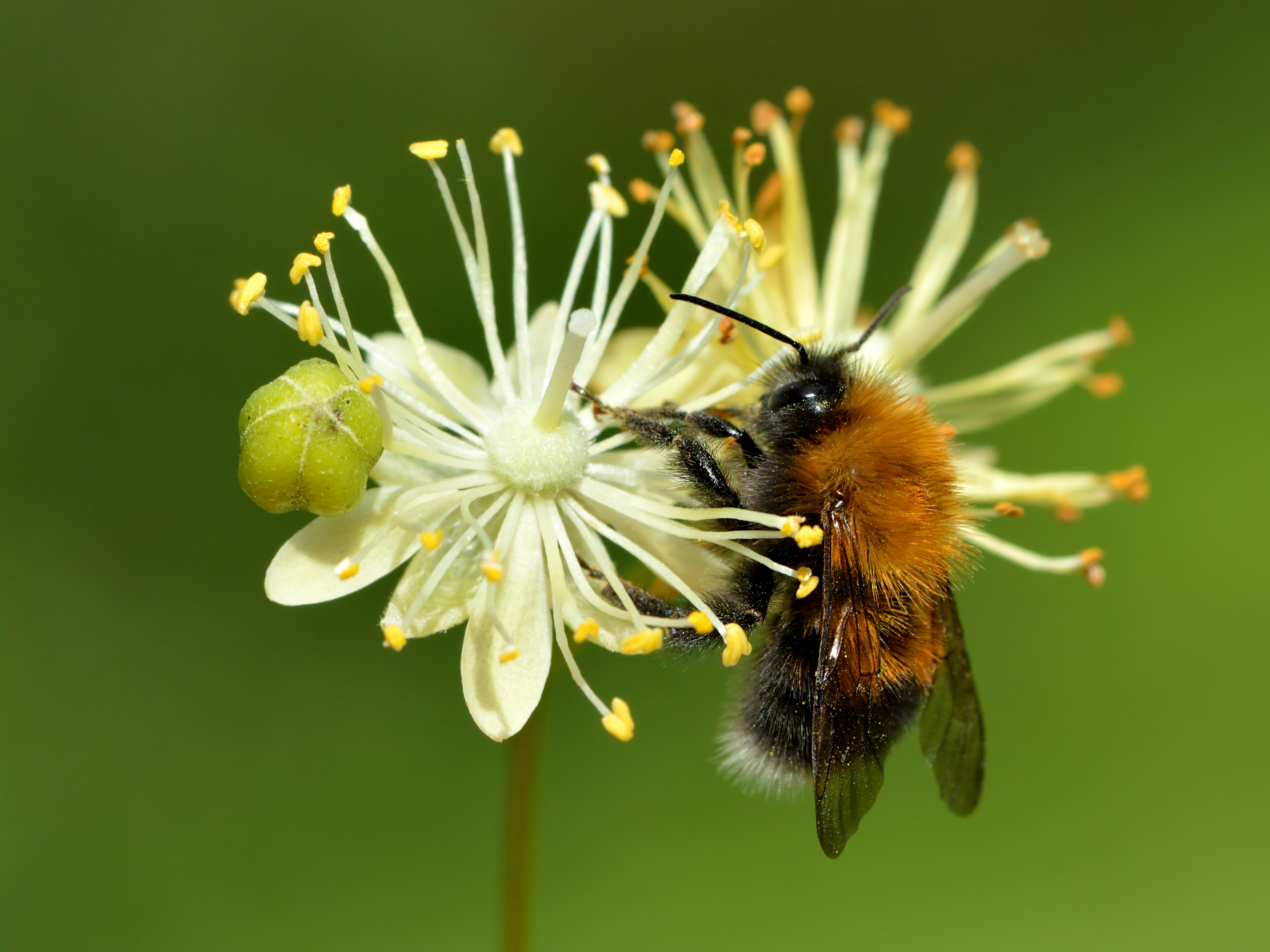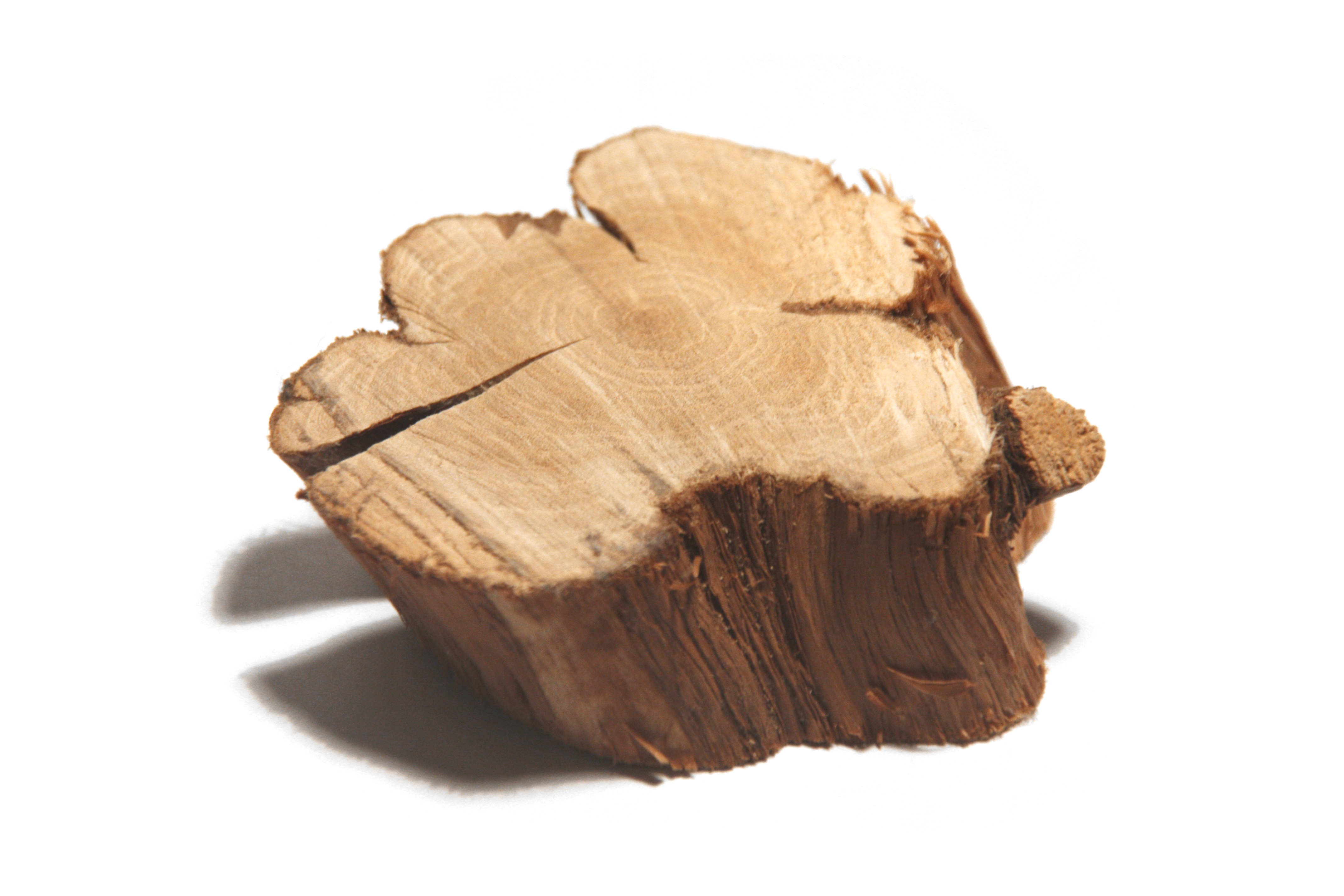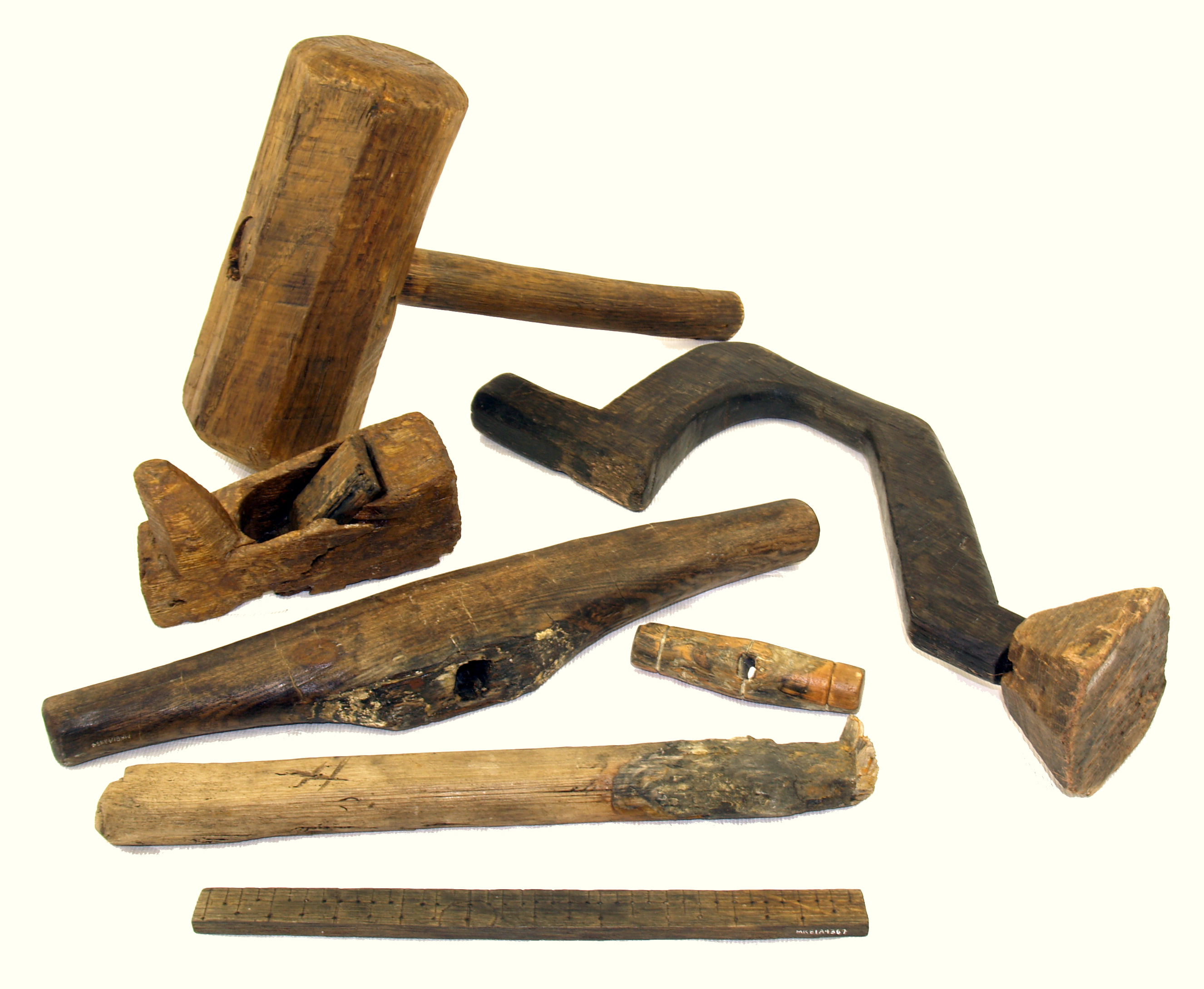|
Heartwood
Wood is a structural tissue/material found as xylem in the stems and roots of trees and other woody plants. It is an organic materiala natural composite of cellulosic fibers that are strong in tension and embedded in a matrix of lignin that resists compression. Wood is sometimes defined as only the secondary xylem in the stems of trees, or more broadly to include the same type of tissue elsewhere, such as in the roots of trees or shrubs. In a living tree, it performs a mechanical-support function, enabling woody plants to grow large or to stand up by themselves. It also conveys water and nutrients among the leaves, other growing tissues, and the roots. Wood may also refer to other plant materials with comparable properties, and to material engineered from wood, woodchips, or fibers. Wood has been used for thousands of years for fuel, as a construction material, for making tools and weapons, furniture and paper. More recently it emerged as a feedstock for the production of ... [...More Info...] [...Related Items...] OR: [Wikipedia] [Google] [Baidu] |
Tree
In botany, a tree is a perennial plant with an elongated stem, or trunk, usually supporting branches and leaves. In some usages, the definition of a tree may be narrower, e.g., including only woody plants with secondary growth, only plants that are usable as lumber, or only plants above a specified height. But wider definitions include taller palms, tree ferns, bananas, and bamboos. Trees are not a monophyletic taxonomic group but consist of a wide variety of plant species that have independently evolved a trunk and branches as a way to tower above other plants to compete for sunlight. The majority of tree species are angiosperms or hardwoods; of the rest, many are gymnosperms or softwoods. Trees tend to be long-lived, some trees reaching several thousand years old. Trees evolved around 400 million years ago, and it is estimated that there are around three trillion mature trees in the world currently. A tree typically has many secondary branches supported cle ... [...More Info...] [...Related Items...] OR: [Wikipedia] [Google] [Baidu] |
Plant Stem
A stem is one of two main structural axes of a vascular plant, the other being the root. It supports leaf, leaves, flowers and fruits, transports water and dissolved substances between the roots and the shoots in the xylem and phloem, engages in photosynthesis, stores nutrients, and produces new living tissue. The stem can also be called the culm, halm, haulm, stalk, or thyrsus. The stem is normally divided into nodes and internodes: * The nodes are the points of attachment for leaves and can hold one or more leaves. There are sometimes axillary buds between the stem and leaf which can grow into branches (with leaf, leaves, conifer cones, or inflorescence, flowers). Adventitious roots (e.g. brace roots) may also be produced from the nodes. Vines may produce tendrils from nodes. * The internodes distance one node from another. The term "Shoot (botany), shoots" is often confused with "stems"; "shoots" generally refers to new fresh plant growth, including both stems and other str ... [...More Info...] [...Related Items...] OR: [Wikipedia] [Google] [Baidu] |
Hornbeam
Hornbeams are hardwood trees in the plant genus ''Carpinus'' in the family Betulaceae. Its species occur across much of the temperateness, temperate regions of the Northern Hemisphere. Common names The common English name ''hornbeam'' derives from the hardness of the woods (likened to Horn (anatomy), horn) and the Old English ''beam'', "tree" (cognate with Dutch ''Boom'' and German ''Baum''). The American hornbeam is also occasionally known as blue-beech, ironwood, or musclewood, the first from the resemblance of the bark to that of the American beech ''Fagus grandifolia'', the other two from the hardness of the wood and the muscled appearance of the trunk and limbs. The botanical name for the genus, ''Carpinus'', is the original Latin name for the European species, although some etymologists derive it from the Celtic for a yoke. Description Hornbeams are small, slow-growing, understory trees with a natural, rounded form growing tall and wide; the exemplar species—the ... [...More Info...] [...Related Items...] OR: [Wikipedia] [Google] [Baidu] |
Tilia Cordata
''Tilia cordata'', the small-leaved lime or small-leaved linden, is a species of tree in the family Malvaceae, native to much of Europe. Other common names include little-leaf or littleleaf linden, or traditionally in South East England, pry or pry tree. Its range extends from Great Britain, Britain through mainland Europe to the Caucasus and western Asia. In the south of its range it is restricted to high elevations. Description ''Tilia cordata'' is a deciduous tree growing to tall, diameter 1/3 to 1/2 the height, with a trunk up to diameter. The largest known trunk circumference was a specimen in Närke, Sweden, that measured circumference at chest height. There are lime trees in Germany that are said to be over 1000 years old. The bark is smooth and grayish when young, firm with vertical ridges and horizontal fissures when older. The crown is rounded in a formal oval shape to pyramidal. Branching is upright and increases in density with age. The leaf, leaves are alternately ... [...More Info...] [...Related Items...] OR: [Wikipedia] [Google] [Baidu] |
Woodchips
Woodchips are small- to medium-sized pieces of wood formed by cutting or chipping larger pieces of wood such as trees, branches, logging residues, Tree stump, stumps, roots, and wood waste. Woodchips may be used as a biomass solid fuel and are raw material for producing wood pulp. They may also be used as an organic mulch in gardening, landscaping, and ecosystem restoration; in bioreactors for denitrification; and as a substrate for mushroom cultivation. The process of making woodchips is called wood chipping and is done using a Woodchipper, wood chipper. The types of woodchips formed following chipping is dependent on the type of wood chipper used and the material from which they are made. Woodchip varieties include: forest chips (from forested areas), wood residue chips (from untreated wood residues, recycled wood and off-cuts), sawing residue chips (from sawmill residues), and short rotation forestry chips (from energy crops). Raw materials The raw materials of woodchips ca ... [...More Info...] [...Related Items...] OR: [Wikipedia] [Google] [Baidu] |
Woody Plant
A woody plant is a plant that produces wood as its structural tissue and thus has a hard stem. In cold climates, woody plants further survive winter or dry season above ground, as opposed to Herbaceous plant, herbaceous plants that die back to the ground until Spring (season), spring. Characteristics Woody plants are usually trees, shrubs, or lianas. These are usually perennial plants whose stems and larger roots are reinforced with wood produced from secondary xylem. The main stem, larger branches, and roots of these plants are usually covered by a layer of Bark (botany), bark. Wood is a structural cell (biology), tissue that allows woody plants to grow from above ground stems year after year, thus making some woody plants the largest and tallest terrestrial plants. Woody plants, like Herbaceous plant, herbaceous perennials, typically have a Dormancy, dormant period of the year when growth does not take place. This occurs in Temperate climate, temperate and Continental clima ... [...More Info...] [...Related Items...] OR: [Wikipedia] [Google] [Baidu] |
Larch
Larches are deciduous conifers in the genus ''Larix'', of the family Pinaceae (subfamily Laricoideae). Growing from tall, they are native to the cooler regions of the northern hemisphere, where they are found in lowland forests in the high latitudes, and high in mountains further south. Larches are among the dominant plants in the boreal forests of Siberia and Canada. Although they are conifers, larches are deciduous trees that lose their needles in the autumn. Description and distribution The tallest species, '' Larix occidentalis'', can reach . Larch tree crowns are sparse, with the major branches horizontal; the second and third order branchlets are also ± horizontal in some species (e.g. '' L. gmelinii'', '' L. kaempferi''), or characteristically pendulous in some other species (e.g. '' L. decidua'', '' L. griffithii''). Larch shoots are dimorphic, with leaves borne singly on long shoots typically long and bearing several buds, and in dense clusters of 20–50 need ... [...More Info...] [...Related Items...] OR: [Wikipedia] [Google] [Baidu] |
Tool
A tool is an Physical object, object that can extend an individual's ability to modify features of the surrounding environment or help them accomplish a particular task. Although many Tool use by animals, animals use simple tools, only human beings, whose use of stone tools dates back hundreds of millennia, have been observed using tools to make other tools. Early human tools, made of such materials as Rock (geology), stone, bone, and wood, were used for the preparation of food, hunting, the manufacture of weapons, and the working of materials to produce clothing and useful Cultural artifact, artifacts and crafts such as pottery, along with the construction of housing, businesses, infrastructure, and transportation. The development of metalworking made additional types of tools possible. Harnessing energy sources, such as Working animal, animal power, wind, or steam, allowed increasingly complex tools to produce an even larger range of items, with the Industrial Revolution markin ... [...More Info...] [...Related Items...] OR: [Wikipedia] [Google] [Baidu] |
Construction Material
This is a list of building materials. Many types of building materials are used in the construction industry to create buildings and structures. These categories of materials and products are used by architects and construction project manager A project manager is a professional in the field of project management. Project managers have the responsibility of the Project planning, planning, procurement and execution of a project, in any undertaking that has a defined scope, defined star ...s to specify the materials and methods used for building projects. Some building materials like cold rolled steel framing are considered modern methods of construction, over the traditionally slower methods like blockwork and timber. Catalogs Catalogs distributed by architectural product suppliers are typically organized into these groups. Industry standards The Construction Specifications Institute maintains the following industry standards: * MasterFormat 50 standard divisions of b ... [...More Info...] [...Related Items...] OR: [Wikipedia] [Google] [Baidu] |
Fuel
A fuel is any material that can be made to react with other substances so that it releases energy as thermal energy or to be used for work (physics), work. The concept was originally applied solely to those materials capable of releasing chemical energy but has since also been applied to other sources of heat energy, such as Nuclear power, nuclear energy (via nuclear fission and nuclear fusion). The heat energy released by reactions of fuels can be converted into mechanical energy via a heat engine. Other times, the heat itself is valued for warmth, cooking, or industrial processes, as well as the illumination that accompanies combustion. Fuels are also used in the Cell (biology), cells of organisms in a process known as cellular respiration, where organic molecules are oxidized to release usable energy. Hydrocarbons and related organic molecules are by far the most common source of fuel used by humans, but other substances, including radioactive metals, are also utilized. Fu ... [...More Info...] [...Related Items...] OR: [Wikipedia] [Google] [Baidu] |
Fiber
Fiber (spelled fibre in British English; from ) is a natural or artificial substance that is significantly longer than it is wide. Fibers are often used in the manufacture of other materials. The strongest engineering materials often incorporate fibers, for example carbon fiber and ultra-high-molecular-weight polyethylene. Synthetic fibers can often be produced very cheaply and in large amounts compared to natural fibers, but for clothing natural fibers have some benefits, such as comfort, over their synthetic counterparts. Natural fibers Natural fibers develop or occur in the fiber shape, and include those produced by plants, animals, and geological processes. They can be classified according to their origin: * Vegetable fibers are generally based on arrangements of cellulose, often with lignin: examples include cotton, hemp, jute, flax, abaca, piña, ramie, sisal, bagasse, and banana. Plant fibers are employed in the manufacture of paper and textile ... [...More Info...] [...Related Items...] OR: [Wikipedia] [Google] [Baidu] |
Composite Material
A composite or composite material (also composition material) is a material which is produced from two or more constituent materials. These constituent materials have notably dissimilar chemical or physical properties and are merged to create a material with properties unlike the individual elements. Within the finished structure, the individual elements remain separate and distinct, distinguishing composites from mixtures and solid solutions. Composite materials with more than one distinct layer are called ''composite laminates''. Typical engineered composite materials are made up of a binding agent forming the ''matrix'' and a Filler (materials), filler material (particulates or fibres) giving ''substance'', e.g.: * Concrete, reinforced concrete and masonry with cement, lime or Mortar (masonry), mortar (which is itself a composite material) as a binder * Composite wood such as glulam and plywood with wood glue as a binder * Reinforced plastics, such as fiberglass and fibre-rein ... [...More Info...] [...Related Items...] OR: [Wikipedia] [Google] [Baidu] |








